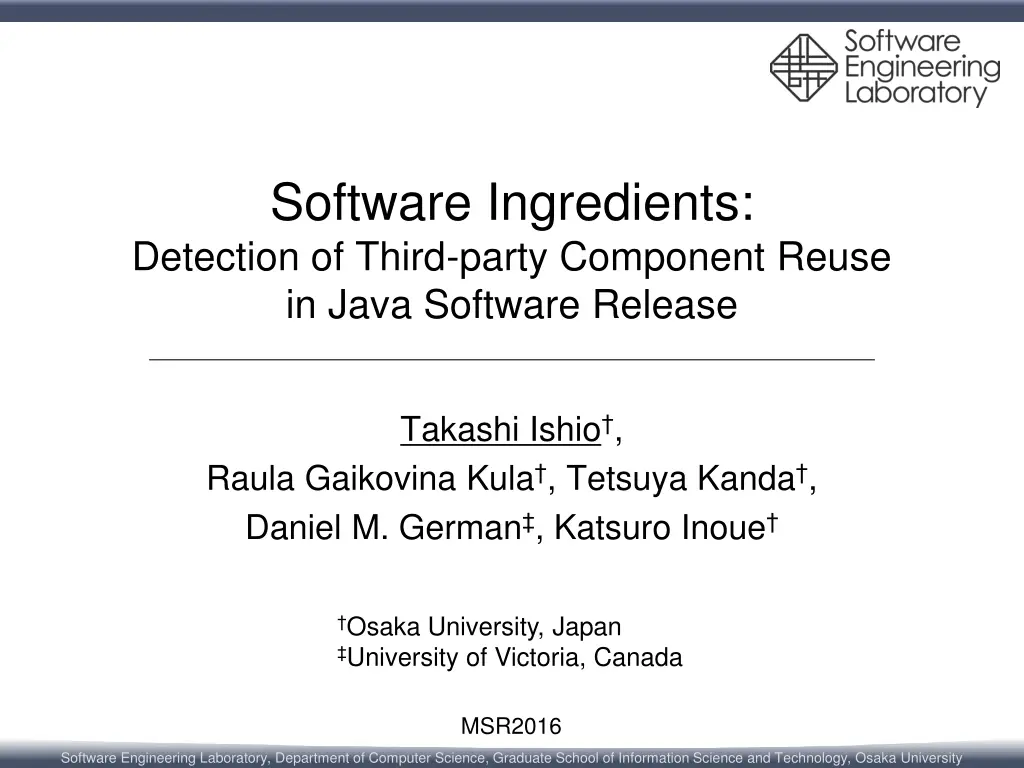
Detection of Third-party Component Reuse in Java Software
Learn about detecting third-party component reuse in Java software releases, the motivation behind software reuse in Java, safety considerations for components, how to detect software components, and actions based on detection results to ensure software security and integrity.
Download Presentation

Please find below an Image/Link to download the presentation.
The content on the website is provided AS IS for your information and personal use only. It may not be sold, licensed, or shared on other websites without obtaining consent from the author. If you encounter any issues during the download, it is possible that the publisher has removed the file from their server.
You are allowed to download the files provided on this website for personal or commercial use, subject to the condition that they are used lawfully. All files are the property of their respective owners.
The content on the website is provided AS IS for your information and personal use only. It may not be sold, licensed, or shared on other websites without obtaining consent from the author.
E N D
Presentation Transcript
Software Ingredients: Detection of Third-party Component Reuse in Java Software Release Takashi Ishio , Raula Gaikovina Kula , Tetsuya Kanda , Daniel M. German , Katsuro Inoue Osaka University, Japan University of Victoria, Canada MSR2016 Software Engineering Laboratory, Department of Computer Science, Graduate School of Information Science and Technology, Osaka University
Motivation: Software Reuse In Java, many binary components are reused in a product binary. Apache Ant Apache Commons Codec Google Web Toolkit 2.7.0 is-made-of Apache Commons Collections Apache HttpClient Apache Xalan HTMLUnit 1 Department of Computer Science, Graduate School of Information Science and Technology, Osaka University
Is it safe? Product Documentation Google Web Toolkit 2.7.0 A partial list of components No version numbers Relevant? Security Advisories #2014-002 Xalan-Java insufficient secure processing arbitrary code can be executed if [Affected versions: before 2.7.2] http://www.ocert.org/advisories/ocert-2014-002.html 2 Department of Computer Science, Graduate School of Information Science and Technology, Osaka University
Detection of Software Components Our tool detects component names and their version numbers in a given jar file. Apache Ant 1.6.5 is-made-of Google Web Toolkit 2.7.0 Apache Commons Codec 1.8 Vulnerability Note VU#576313 Apache Commons Collections library insecurely deserializes data. [Affected versions: 3.2.1, 4.0] https://www.kb.cert.org/vuls/id/576313 Apache Commons Collections 3.2.1 Apache HttpClient 4.3.1 Apache Xalan 2.7.1 #2014-002 Xalan-Java insufficient secure processing arbitrary code can be executed if [Affected versions: before 2.7.2] HtmlUnit 2.13 http://www.ocert.org/advisories/ocert-2014-002.html 3 Department of Computer Science, Graduate School of Information Science and Technology, Osaka University
Actions based on Detection Result Upgrade the whole product if available Upgrade vulnerable components if available Use the product in a safe environment if upgrade is impossible Accept a risk (Continue to use the product) if vulnerability conditions are unsatisfiable 4 Department of Computer Science, Graduate School of Information Science and Technology, Osaka University
How to Detect Components Component Database (e.g. Maven.org) Input: a jar file includes? gwt-dev-2.7.0.jar ant-1.6.4.jar ant-1.6.5.jar ant-1.7.0.jar A Output: jar files that are the most likely included in the input file collections-3.2.0.jar collections-3.2.1.jar ant-1.6.5.jar collections-3.2.2.jar collections-3.2.1.jar 5 Department of Computer Science, Graduate School of Information Science and Technology, Osaka University
A previous work: Software Bertillonage Compare classes using identifiers (e.g. package/class/method names). A similarity between jar files is defined as Jaccard Index:|? ?| |? ?| Database Input: [X-1.0.jar] Class Signature A 7fabc... B ff1dc... C 07a21... [target.jar] Class Signature A 7fabc... B ff1dc... C 07a21... E 920b4... F 6b9a3... G a18e0... |? ?| |? ?| 0.5 0.286 0.167 0.333 Likely Included? Component [X-1.1.jar] Class Signature A 7fabc... C 07a21... D 35e23... X-1.0.jar X-1.1.jar Y-0.1.jar Z-0.2.jar [Y-0.1.jar] Class Signature E 920b4... [Z-0.2.jar] Class Signature E 920b4... F 6b9a3... A user has to manually identify original components using the information. 6 Department of Computer Science, Graduate School of Information Science and Technology, Osaka University
The key difference: Greedy search Strategy: Select the largest, entirely copied jar file Database Input: [X-1.0.jar] Class Signature A 7fabc... B ff1dc... C 07a21... [target.jar] Class Signature A 7fabc... B ff1dc... C 07a21... E 920b4... F 6b9a3... G a18e0... [X-1.1.jar] Class Signature A 7fabc... C 07a21... D 35e23... [Y-0.1.jar] Class Signature E 920b4... [Z-0.2.jar] Class Signature E 920b4... F 6b9a3... 7 Department of Computer Science, Graduate School of Information Science and Technology, Osaka University
The key difference: Greedy search Strategy: Select the largest, entirely copied jar file Database Input: [X-1.0.jar] Class Signature A 7fabc... B ff1dc... C 07a21... [target.jar] Class Signature A 7fabc... B ff1dc... C 07a21... E 920b4... F 6b9a3... G a18e0... 3 classes Greedy Search in this example: 1. Select X-1.0 because it provides 3 of 6 classes. [X-1.1.jar] Class Signature A 7fabc... C 07a21... D 35e23... [Y-0.1.jar] Class Signature E 920b4... [Z-0.2.jar] Class Signature E 920b4... F 6b9a3... 8 Department of Computer Science, Graduate School of Information Science and Technology, Osaka University
The key difference: Greedy search Strategy: Select the largest, entirely copied jar file Database Input: [X-1.0.jar] Class Signature A 7fabc... B ff1dc... C 07a21... [target.jar] Class Signature A 7fabc... B ff1dc... C 07a21... E 920b4... F 6b9a3... G a18e0... Greedy Search in this example: 1. Select X-1.0 because it provides 3 of 6 classes. 2. Select Z-0.2 because it provides 2 of 3 remaining classes. [X-1.1.jar] Class Signature A 7fabc... C 07a21... D 35e23... [Y-0.1.jar] Class Signature E 920b4... 2 classes [Z-0.2.jar] Class Signature E 920b4... F 6b9a3... 9 Department of Computer Science, Graduate School of Information Science and Technology, Osaka University
The key difference: Greedy search Strategy: Select the largest, entirely copied jar file Database Input: [X-1.0.jar] Class Signature A 7fabc... B ff1dc... C 07a21... [target.jar] Class Signature A 7fabc... B ff1dc... C 07a21... E 920b4... F 6b9a3... G a18e0... Greedy Search in this example: 1. Select X-1.0 because it provides 3 of 6 classes. 2. Select Z-0.2 because it provides 2 of 3 remaining classes. 3. X-1.1 and Y-0.1 are not selected because they do not cover the remaining class G. [X-1.1.jar] Class Signature A 7fabc... C 07a21... D 35e23... [Y-0.1.jar] Class Signature E 920b4... [Z-0.2.jar] Class Signature E 920b4... F 6b9a3... 10 Department of Computer Science, Graduate School of Information Science and Technology, Osaka University
The key difference: Greedy search Strategy: Select the largest, entirely copied jar file Database Input: [X-1.0.jar] Class Signature A 7fabc... B ff1dc... C 07a21... [target.jar] Class Signature A 7fabc... B ff1dc... C 07a21... E 920b4... F 6b9a3... G a18e0... Greedy Search in this example: 1. Select X-1.0 because it provides 3 of 6 classes. 2. Select Z-0.2 because it provides 2 of 3 remaining classes. 3. X-1.1 and Y-0.1 are not selected because they do not cover the remaining class G. [X-1.1.jar] Class Signature A 7fabc... C 07a21... D 35e23... [Y-0.1.jar] Class Signature E 920b4... is-made-of [Z-0.2.jar] Class Signature E 920b4... F 6b9a3... 11 Department of Computer Science, Graduate School of Information Science and Technology, Osaka University
Experiment to evaluate accuracy Comparison with the previous work Component database: Sourcerer Dataset (172,232 jar files) A snapshot of Maven repository on August, 2012. 1,000 artificial products: We randomly selected 10 1,000 components and repackaged them into a single jar file. Randomly selected components Our method and the previous work Reported components Copy classes ant-1.6.5.jar ant-1.6.5.jar commons- codec-1.8.jar collections- 3.2.1.jar 3.2.1.jar ant-1.6.5.jar commons- codec-1.8.jar collections- An artificially mixed jar file commons- codec-1.8.jar collections- 3.2.1.jar Verify the result (Compute precision and recall) 12 Department of Computer Science, Graduate School of Information Science and Technology, Osaka University
Result: Precision and Recall The previous work Our method Precision: Recall: 0.357 0.998 Improved! 0.993 0.997 13 Department of Computer Science, Graduate School of Information Science and Technology, Osaka University
Conclusion Our method detects components in a Java binary file. Compare a binary with all the components in a database Introduced a greedy search to select reused components Precision: 0.357 0.998 Recall: 0.993 0.997 Our simple implementation (< 2.5KLOC) is available on GitHub http://www.github.com/takashi-ishio/JIngredients/ Future Work Component detection in source code Empirical studies on inter-project code reuse 14 Department of Computer Science, Graduate School of Information Science and Technology, Osaka University
15 Department of Computer Science, Graduate School of Information Science and Technology, Osaka University
Limitation The experiment is performed on an ideal situation: The database included all the reused components. In reality, it is not so easy to keep all the components. Our method and the previous work use identifiers (e.g. package names, class names) to compare classes. Our method is applicable to release engineering activities and open source projects. Our method is inapplicable to obfuscated code. We need a technique to identify similar classes in obfuscated code. 16 Department of Computer Science, Graduate School of Information Science and Technology, Osaka University
Q. Component dependencies are managed by a tool such as Maven -- Is it insufficient? A. Insufficient. Because some components have an internal copy of their dependent components. For example, GWT re-packages all the dependent components to simplify dependencies. The dependent components, e.g. Ant and Xalan, do not appear in pom files of GWT users. 17 Department of Computer Science, Graduate School of Information Science and Technology, Osaka University
Q. Why dont you use a MD5 file hash to compare classes? A file hash (e.g. SHA-1, MD5) cannot compare classes, because different compilers generate different binary files. JDK version and debug information also affects binary files. Davies et al. reported that 48% of jar files in Debian GNU/Linux have no class files that were identical to any classes in the Maven Central Repository. 18 Department of Computer Science, Graduate School of Information Science and Technology, Osaka University

